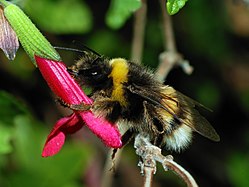Bumblebee
Bumblebees (or Bumble bees, or Humble bees) are a group of social and semi-social bees, of the genus Bombus. The genus contains about 250 different species, mostly in the Northern Hemisphere. They can also be found in New Zealand and Tasmania. They occur practically everywhere on the Eurasian landmass.
| Bombus | |
|---|---|

| |
| Female Bombus terrestris cutting a flower to take its nectar | |
| Scientific classification | |
| Kingdom: | |
| Phylum: | |
| Class: | |
| Order: | |
| Family: | |
| Subfamily: | |
| Tribe: | Bombini
|
| Genus: | Bombus Latreille, 1802
|
| Species | |
|
More than 250 species in 15 subgenera. | |
Most bumblebees live in small groups, which generally last only for a year. They collect pollen as protein for their young, and themselves eat nectar. They are extremely hairy, with a covering of soft hairs called a pile.
Most of them have the same social structure as honey bees do, there is a queen, and there are workers and drones. The usual size of a colony is under 50 members, though some tropical species live in larger colonies.
Bumblebees carry aposematic warning colours, usually some combination of black, red, yellow and white. This is the usual Müllerian mimicry found in bees and wasps.[1]
Life cycle
Fertilised queens overwinter in a dormant state. They start a nest in the Spring. The queen stores sperm from her mating, and can decide whether or not to fertilise an egg as it comes down the oviduct. The females are diploid, the males are haploid. This is the common method of sex determination throughout the Hymenoptera.
Only fertilised eggs grow into females, unfertilised ones grow into males. Queens suppress their female workers egg-laying by aggression and pheromones, until late in the season, when the workers do start to lay eggs.[2]
Thus the queen will be the mother of all the first males. New queens and males leave the colony when they are mature; they mate and the new queens search for a place to overwinter. Then they are dormant over the winter period, starting a new nest in the Spring. That completes the cycle.[3]
Parasitic bees
About ten species are called cuckoo bumblebees. These are nest parasites: they specialize in invading and taking over the nests of other bumblebees. In these species, there are no workers. Once such an animal has invaded a nest, it will force the workers to feed it and its offspring. Once the offspring are ready, they will leave the hive, to mate and take over other hives.
Sting
All bumblebees have a sting, as hive bees do. However, the bumblebee sting does not damage it when used, and they can sting several times. However, they rarely do sting, unless really threatened.
They have an additional type of defence against birds, and that is their mechanical toughness. Birds usually do not swallow bees whole. If they eat bees at all, they manipulate them to eat the thorax alone, for its wing muscles. This is hard to do with a bumblebee, and time-consuming. Generally, they are left alone.
Bumblebees in England
The BBC has made a number of field reports for its regular Naturewatch and Spring watch programs.[4] The short film clips have information on:
- Bumblebee flight
- How to tell a hoverfly from a bumblebee
- Bumblebee nests
- Film of animals preying on bumblebees (Great Tits, crows, mice, squirrels, badgers...)
- Cuckoo bumblebees, which are parasitic on their honey and/or grubs.
BB guide
- Genus Bombus, the bumble bees. BugGuide. [1]
References
- ↑ "Williams PH. 2007. The distribution of bumblebee colour patterns world-wide: possible significance for thermoregulation, crypsis, and warning mimicry. Biological Journal of the Linnean Society 92: 97-118". Retrieved 2007-07-09.
- ↑ Van Honk, C.G.J. (1980). "The mandibular glands of Bombus terrestris queens as a source of queen pheromones". Entomologia Experimentalis et Applicata. 28 (2): 191–198. doi:10.1007/BF00287128.
{{cite journal}}: Unknown parameter|coauthors=ignored (|author=suggested) (help) - ↑ Fletcher, D.J.C. (1985). "Regulation of reproduction in eusocial Hymenoptera". Annual Reviews in Entomology. 30: 319–343. doi:10.1146/annurev.en.30.010185.001535.
{{cite journal}}: Unknown parameter|coauthors=ignored (|author=suggested) (help) - ↑ BBC Nature: bumblebee videos, news and facts


